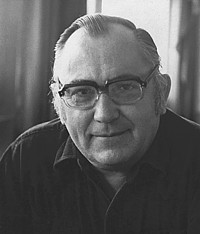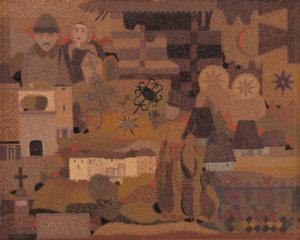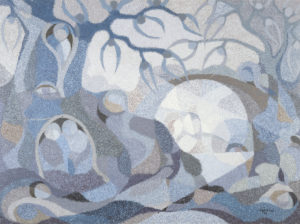
Imre Égerházi
painter artist (1925 – 2001)
By the new millennium Imre Égerházi was regarded as one of the Hungarian Great Plain’s leading masters. He had gained great recognition in Hungary and beyond its borders for his art and his organizational work in the world of art. In the course of his life he received twenty-one state and professional honors. His paintings can be seen in the Hungarian National Gallery, in the Imre Égerházi Memorial Center in Hajdúhadház, the Déri Museum in Debrecen, and in museums, public institutions and private collections in Hungary and abroad.
Imre Égerházi was born in Hajdúhadház, Hungary, 2nd of September 1925. He was a descendant of János Egerházi Képíró, a 17th-century fresco artist from Mezőbánd, Transylvania.
In his autobiography Imre Égerházi writes that among his ancestors were painters who received conferred nobility for their services from Rákóczi Prince George the first. Their family crest depicts a knight holding a sword in his left hand and a paint brush and palette in his right. The roots of the talent, ability and instinctive interest of the young boy from Hadház extended widely in space and time from his first drawings with a box of colorful chalk on clean walls to the brush and palette.

He developed a very distinctive and well recognizable artistic world and a unique way of communicating through his paintings. This was by no means without precedents: his visual construction mode was formed by folk art and the secessionist movement, his use of color was influenced by post-impressionism, and his entire artistic approach was shaped by the Alföld art world, yet the end result truly characterizes the individual painting style of Imre Égerházi. His works are unique not only in their technique, construction, and composition, but also in the internally driven choice of themes and their honest interpretation.
His art was directly derived from and determined by his own life – including personal and social experiences , and landscape impressions. Despite his well-articulated artistic composition, construction and abstraction, his paintings do not make an artificial or abstract impression, because the life episodes, landscapes, people, houses, objects and symbols that he chose to express, all evoke real-life sceneries. The dense, contoured and powerful shapes and figures, and finer, more intimate ambiances are all built with a very detailed, atom-like surface treatment technique, very characteristic of his paintings, applied with a uniquely interpreted pointillism. In his work, this way of constructing colors serves an artistic intention: The audience is guided by the meticulous details of the story and is not weighed down by grand statements. The details come together in harmony across the entire canvas.

One of his series of paintings was created after he had returned from the gates of death, following a heart attack. While many have verbally described what such an experience might feel like, the way Égerházi portrays it, truly bears an authentic force, because it shows the visions of a painter. These images of the afterlife are symbolic. His desire to become a painter turned into reality, his nobleness was enforced, and wherever he is now, I believe he still is and will always remain a true painter.
Gábor Prókai
ast historian
In the early 1930s, when he was a small child, his family moved to Debrecen. There, in the fifties, he attended the Free School of Fine Arts, studying under the painter József Menyhárt. He always maintained active links with his hometown, Hajdúhadház to which he donated a large part of his oeuvre in 1985, and he added to this collection for the rest of his life. Hajdúhadház provided Imre Égerházi with a creative center, which was more than a studio: it was also an important meeting place for the region’s artists. After his death the creative center continued to operate as a memorial center, where one can view more than one hundred outstanding works from his life’s work.
Imre Égerházi created an internationally unique exhibition of panel paintings in the Földi János Bilingual Primary School and Elementary Art School in Hajdúhadház. He not only painted two outstandingly important panel paintings for his former school, but also asked his European and American painter friends to do the same.
The Hajdúhadház Gallery was also his brainchild and creation. He did much for the town as an artist, artistic organizer, and committed supporter of youth. In recognition of all this Hajdúhadház awarded him Freedom of the City in 1992.
 From 1962 onwards Imre Égerházi exhibited in more than one hundred solo and four hundred group exhibitions, from Europe to the United States to Japan.
From 1962 onwards Imre Égerházi exhibited in more than one hundred solo and four hundred group exhibitions, from Europe to the United States to Japan.
He relentlessly worked to channel his homeland into the domestic and international art world – leveraging the colorful palette of his art and his undepletable energy. He led and contributed to the launch of art communities and creative camps, single handedly taking on the multitude of tasks that came along with it. He became the spiritual leader of creating such art formations.
In 1964 he was a founding member of the Hajdúböszörmény International Artists’ Colony, where he worked for thirty years. For twenty years from the early 1970s he took part in the Working Exhibitions series, which he led in its final ten years.
In 1982 he re-established the Hortobágy Artists’ Camp, which he led until his passing. Under his direction the Hortobagy Artists’ Camp grew to be an influential international colony of painters and photographers.
From the end of the 1960s until the year of his death he was the most prominent Hungarian patron of Hungarian artists abroad. Before the fall of communism, on several occasions he personally invited to the two colonies Hungarian artists from neighboring countries. Considering the authorities of the time, this was at no small risk to himself personally.
He helped these artists by providing tranquil surroundings to work in, and the opportunity to exhibit and establish contacts, catalogues, and financial support. He formed Hungarian painters, graphic designers, and photographers into unique, open communities, which were joined by large numbers of artists from all over the world. In this way Hajdúság and Hortobágy became part of the international art world.
 As a result of his work at the art colonies and the quality of his art, Imre Égerházi often received invitations from art camps abroad. He regularly visited Gyergyószárhegy and Nagybánya (in Romania). Other international art colonies in which Imre Égerházi spent a significant amount of time included the following: Szabadka/Subotica (Serbia); Grožnjan (Croatia); Dubrinics, Kamianka, Munkács/Mukacheve (Ukraine); Kazimierz Dolny, Lublin (Poland); Potsdam (Germany); and Bessans, St. Michel in France and many more.
As a result of his work at the art colonies and the quality of his art, Imre Égerházi often received invitations from art camps abroad. He regularly visited Gyergyószárhegy and Nagybánya (in Romania). Other international art colonies in which Imre Égerházi spent a significant amount of time included the following: Szabadka/Subotica (Serbia); Grožnjan (Croatia); Dubrinics, Kamianka, Munkács/Mukacheve (Ukraine); Kazimierz Dolny, Lublin (Poland); Potsdam (Germany); and Bessans, St. Michel in France and many more.
The study tours he went on took him to: Shumen (Bulgaria), Klaipeda, Neringa (Lithuania) and Jyväskylä (Finland). He received funding for some such tours from the city of Debrecen in recognition of his work and as further encouragement for his career. In the 1990s he was elected honorary president of the French Association Les Européennes de l’Art en Thiérache.
By the new millennium Imre Égerházi was regarded as one of the Alföld’s leading masters. He had gained great recognition in Hungary and beyond its borders for his art and his organizational work in the world of art.
He worked with undiminished vigor up until his death, continuing in his office job until 1985, as he could only focus exclusively on his painting and organization of artists’ colonies after his retirement. He saw the financial security of his family as even more important than his creative work.
Imre Égerházi not only worked for his own artistic success, but he also did much for artistic communities and colleagues. For this reason he was respected and loved more than most.
In the course of his life he received twenty-one state and professional honors. His paintings can be seen in the Hungarian National Gallery, and his oeuvre is represented in the Imre Égerházi Memorial Center in Hajdúhadház, the Déri Museum in Debrecen, and in museums, public institutions and private collections in Hungary and abroad.

